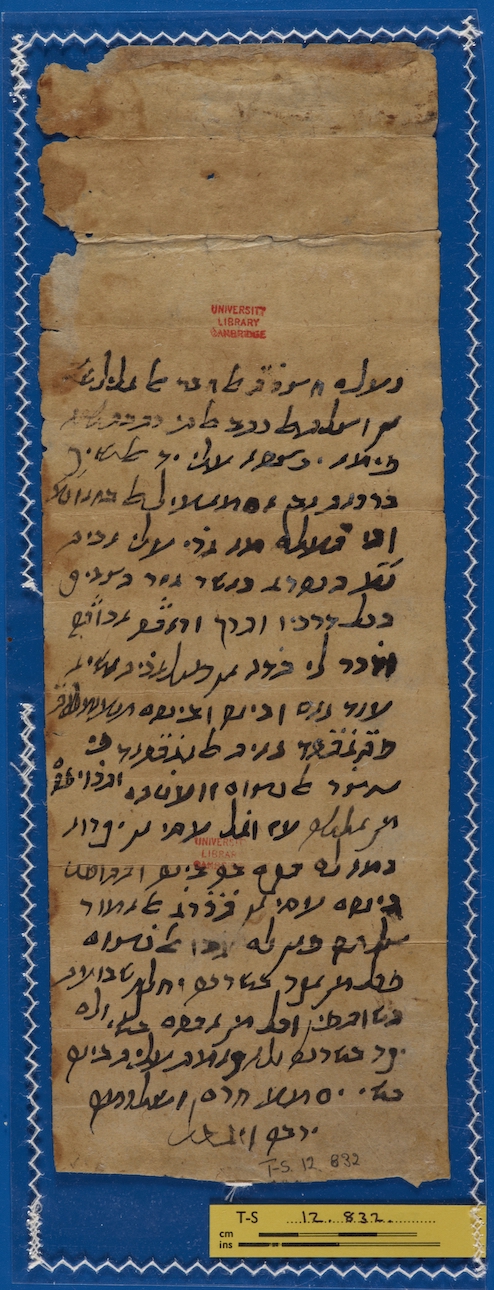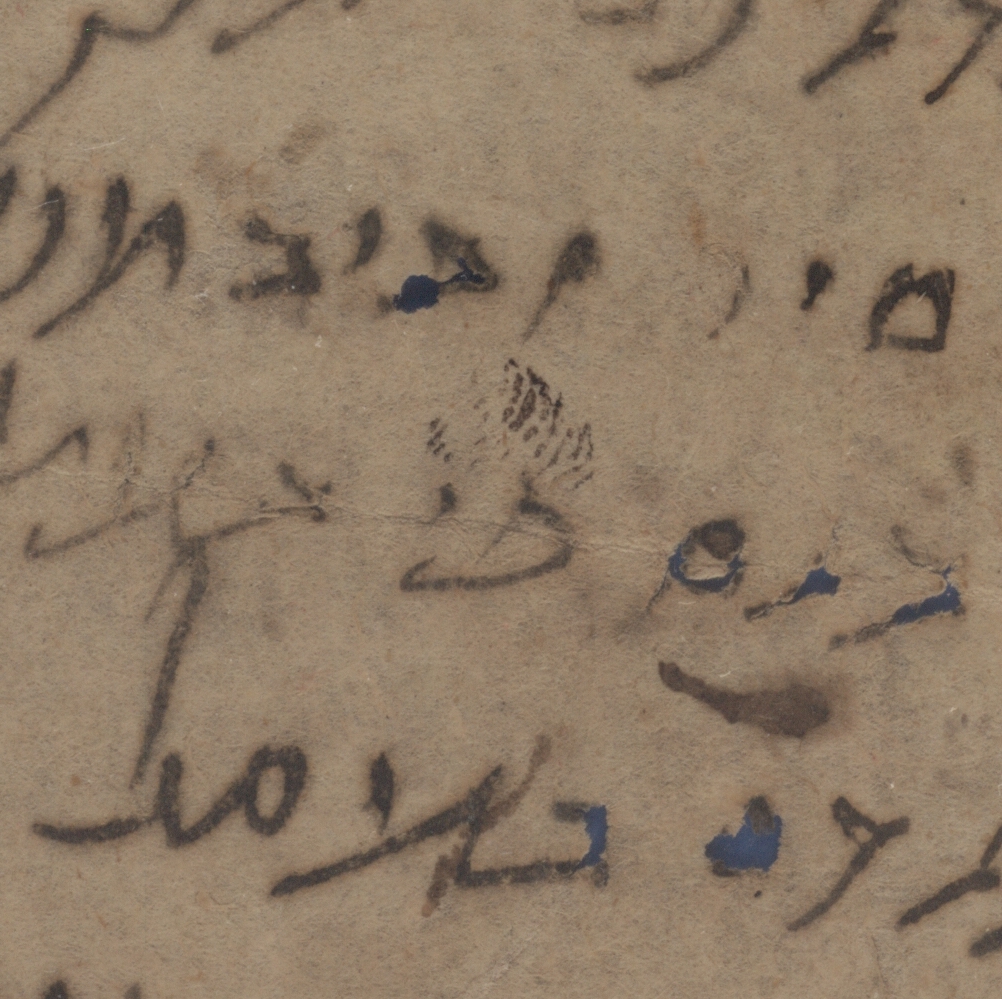Throwback Thursday: Maimonides’ letters yield their secrets

Our Throwback Thursday this week is taken from issue 16 of the printed edition of Genizah Fragments, published in October 1988, by Joel Kraemer:
The importance of the Cambridge Genizah for the study of Maimonides manuscripts is widely acclaimed. Not long ago, Dr David Goldstein (of blessed memory) delivered a lecture at Cambridge on these manuscripts (see Genizah Fragments 11, April, 1986).
The survival of a striking number of autographs is, of course, especially gratifying. Most Maimonides autographs discovered before 1952 were recorded by S. D. Sassoon in the introduction to Maimonidis commentarius in Mischnam, I, with facsimiles in plates XX–LXI. A number of autographs were discovered after Sassoon's publication and were listed by Simon Hopkins in the Journal of Semitic Studies 28 (August, 1983), 273–6. In recent years, several autographs have been added to the inventory.
We may assume that most extant Maimonides autographs have by now been identified. Uncovering a new one is thus becoming quite a rare experience.
Before visiting the Cambridge Genizah in November, 1987, in connection with my translation of Maimonides’ letters and (selected) responsa, I prepared a list of manuscripts to study, including a letter in T-S 12.832, which I had come across in S.D. Goitein’s “Laboratory” at the Jewish National and University Library in Jerusalem. When I first set eyes on the document at Cambridge, I was immediately struck that it was an autograph, an impression supported by comparison with examples of Maimonides’ handwriting (using tracings). Later, perusing his “Laboratory”, I found that on another card Goitein had indeed noted that the document was in Maimonides’ hand.
My colleague, Professor M.A. Friedman, further confirmed that the text is an autograph and kindly discussed it with me.
The letter is evidently a draft copy and thus begins abruptly without greetings and is not signed. The document measures ca. 29 x 10 cms. The writing begins about 9 cms. from the top. There is a 1 cm. margin at the bottom and a 1cm. margin on the right side. The manuscript has 20 lines.
I have edited the letter for publication and offer the gist of it here. The document informs a haver (i.e., member of the academy), presumably a judge, that the letters he had written to Maimonides had arrived per Barakat b. Isma’il al-Bazzaz (the cloth merchant).
A brother of Barakat had been killed, leaving an inheritance to his surviving kin. The deceased had invested with business partners, and the heirs now wished to retrieve their brother’s assets. Maimonides instructs the haver to summon the partners and press them to admit their debt, as no clear evidence exists. The haver is advised to try his utmost to negotiate a settlement between the partners and the heirs. If the business associates are uncooperative, then the haver should bid those who do admit the existence of a partnership to swear an “oath of partners” (as to the amount the deceased had invested). Whoever obfuscates matters, Maimonides concludes, and refuses to own up to a partnership, should be pronounced under a general ban. The literary genre of the document is of interest, for, although in the form of a personal letter, its legal import places it in the category of responsa literature.
New autographs are exciting, but even old friends hold surprises for a visitor to the Cambridge Genizah Collection.
T-S 16.290, a Maimonides autograph letter written on the verso of an inquiry by an anonymous correspondent, was published by D.H. Baneth in Studies in Memory of Asher Gulak and Samuel Klein (Hebrew; Jerusalem, 1942), 50–56. Baneth correctly assessed that Maimonides’ letter is an autograph, noting that it is blurred in places and difficult to decipher. (The letter by the inquirer on the recto is, however, clear.) Baneth worked from a photostat found in material collected by D. Yellin in Cambridge in the summer of 1936 in preparation for the publication of Maimonides’ letters by Meqize Nirdamim. On examining the original document, I discovered that on the verso, containing Maimonides’ response, a number of words and letters that showed up as black in the photostat (thus accounting for the odd formations which puzzled Baneth) were not blurred, but eroded, presumably by oxidation.
Maimonides had clearly used ink that caused shadowing on the recto, fading of the writing and damage to the paper. (The document may have become wet at some time.) The ink used by Maimonides’ correspondent was presumably a vegetal-base ink (perhaps mixed with gall-nut extract), which proved quite durable, whereas Maimonides probably used a metallo-gallic ink, which had the noted effect of oxidation.
Maimonides himself contended, on good grounds, that ink having a metallic base – metallo-gall ink, compounded of gall-nut extract plus vitriol (copper or iron sulphate) (Mishnaic qanqantum; Greek chalkanthon) – is more durable than plain vegetal-base inks, and even more permanent than ink made with a vegetal-base mixed with gall-nut extract.
Vegetal-base ink does not penetrate the fibres of papyrus, parchment or paper, and wear may cause the ink to fade. Hence, for writing a Torah scroll, Maimonides prescribes that vegetal-base ink should be soaked in gall-nut extract. The extract makes the ink durable, though not indelible, and corrections may thus be made. This, Maimonides explains, is the way he himself wrote a scroll, although he permits an ink with the addition of vitriol. (Responsa, ed. Blau, II, no. 136, 257ff; and see Mishneh Torah, Hilkhoth Tefillin, i, 4; Commentary on the Mishnah, Sota, ii, 4.) If Maimonides did use a metallic base ink, as we surmise, then by an irony of fate the most indelible ink proved in the long run to be the most damaging, to the point of illegibility. Mr Alan Farrant, Head of Conservation at Cambridge University Library, and Ms Jayne Ringrose, of the Manuscript Department, were most helpful in advising me in this matter.
I may add that another peculiarity of our manuscript is that above line 20 there appears a small ink fingerprint of approximately 5 cms. which is, presumably, that of the great sage.
Detail of T-S 16.290 (verso), showing what is possibly Maimonides' fingerprint above line 20.
Perusing Maimonides autographs, I discovered that the verso of letters, containing the address, and usually neglected in scholarly discussions and publications, often contains information of great interest.
The autograph letter of Maimonides to al-Shaykh al-Thiqa (“the trusted elder”; T-S 12.192), published by S. Assaf in Texts and Studies in Jewish History (Hebrew; Jerusalem, 1946), 163–66 (= Sinai 14 [1944], 1–2), contains on the verso the name of the addressee, “al-Shaykh al-Thiqa”, in Hebrew characters, along with three words in Arabic characters: fi yaday Ibrahim al-Darʿi (“per Ibrahim al-Darʿi”). Assaf reproduced only the name Ibrahim al-Darʿi and left it without comment. (The Arabic characters are apparently in the hand of Maimonides, and as far as I know are the only example of his Arabic handwriting on documents.) The letter was sent to “al-Shaykh al-Thiqa” at Minyat Zifta through the agency of a man named Isaac al-Darʿi, a newcomer from Morocco and an acquaintance of Maimonides. Ibrahim al-Darʿi must have been a relative or friend of Isaac.
The scenario may have been as follows: Maimonides gave the letter to a courier to bring to the Fustat address of Ibrahim al-Darʿi, who would then have handed it to Isaac for delivery to “al-Shaykh al-Thiqa” in Minyat Zifta. (Isaac, as a newcomer to Fustat, would not have had a proper address.) Assuming that the letter was actually delivered to its destination in Minyat Zifta, we may wonder how it got back to Fustat and to the Genizah. Perhaps Isaac returned with it, or else the recipient brought it to Fustat at some point.
Assaf dates the letter shortly after Maimonides’ arrival in Egypt. Dr Geoffrey Khan, who was kind enough to discuss the handwriting and the verso scenario with me, also regards the document as an early example of Maimonides’ handwriting.
Two unpublished Maimonides letters (noted by Goitein in his “Laboratory” and elsewhere), which I studied at Cambridge and have prepared for publication, are T-S 16.291 and Or.1080 J33. Several letters which I have likewise prepared for publication are of interest because they refer to Maimonides: T-S 12.428, T-S 20.133, T-S 13J34.9, Or. 1080 J88, and Or.1080 J188v.
I wish to thank Dr Stefan C. Reif and Mrs Shulie Reif for their generous help and hospitality, and Superintendent Godfrey Waller and staff for their kindness and forbearance.
What happened next? Kraemer's work in the fields of Judaeo-Arabic, Islamic, and Maimonidean Studies led to a number of publications, including Maimonides: The Life and World of One of Civilization’s Greatest Minds (2008), ‘Six Unpublished Maimonides Letters from the Cairo Genizah’, Maimonidean Studies 2 (1992: 61–94) and ‘Women Speak for Themselves’, in S. C. Reif (ed.), The Cambridge Genizah Collections: Their Contents and Significance (2002: 178–216). When he passed away in 2018 (his obituary in Genizah Fragments was written by Zvi Stampfer) he left two manuscripts in progress: More Precious than Rubies: Women’s Letters from the Cairo Geniza (which is being completed by Renée Levine Melammed), and Maimonides’ Epistles and Personal Correspondence (which Zvi Stampfer is editing for publication).


Add new comment